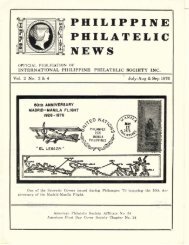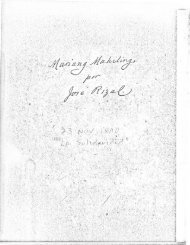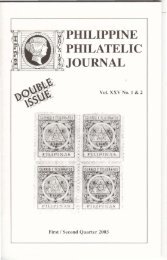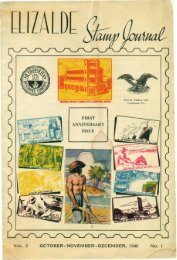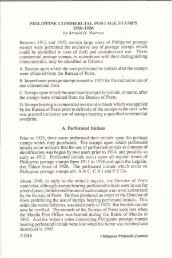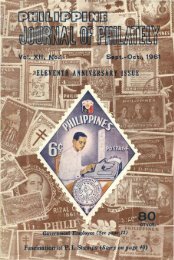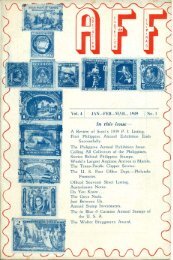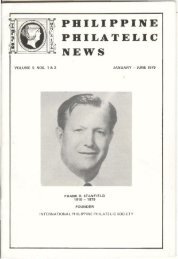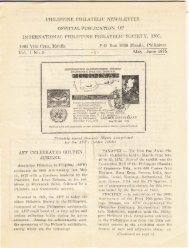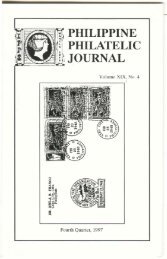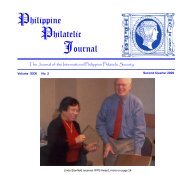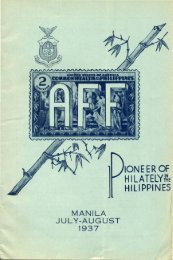March-April 1975 - International Philippine Philatelic Society
March-April 1975 - International Philippine Philatelic Society
March-April 1975 - International Philippine Philatelic Society
You also want an ePaper? Increase the reach of your titles
YUMPU automatically turns print PDFs into web optimized ePapers that Google loves.
Vol. 1 No.2<br />
THRIFT SLOGANS OF THE<br />
PHILIPPINES<br />
By Eugene A. Garrett<br />
"AGIN-INUCTA: LICLICAM DAKES<br />
A PANAGGASTO".<br />
To one who insists upon deciphering all<br />
the markings on his <strong>Philippine</strong> covers and<br />
postal ,statIOnery, this particular marking<br />
was a real head-scratcher. It appears on<br />
the United Postal Stationery <strong>Society</strong> Catalog<br />
No. BIb 4, red McKinley envelope,<br />
postmarked Bootoe, Mountain Prov:nce,<br />
October 8, 1928. applied neatly by rubber<br />
stamp in red ink. My good frienp and<br />
fellow UPSS'er, Robert L. Griffin, Vo-ho<br />
seems to have endless resources concerning<br />
<strong>Philippine</strong> postal history, advised that this<br />
slogan is in llocano dialect, and translates<br />
idiomatically, .fBe thrifty: avoid foolish<br />
spending."<br />
This is one of about HI different "Thrift<br />
Slogans" used in the <strong>Philippine</strong>s from mid<br />
1927 until late 1928 to promot0 a "National<br />
Thrift Campaign". But, are they postal<br />
markings? Well, they were applied<br />
by postal clerks in post offices in Manila<br />
and in many provincial cities and towns<br />
and the purpose was to urge the people to<br />
deposit savlIlgs with the local postmastf'r<br />
in the Postal Savings Bank. 'I'he U.S. system,<br />
d'scontjnued in the States in 1966,<br />
was the model for the <strong>Philippine</strong> Pastal<br />
Saving~ Bank, which continues in operation<br />
to t} e present day, although a recent<br />
presidential decree provides that the Postal<br />
Savings Bank will be phased out in fhe next<br />
couple of years and absorbed into the<br />
<strong>Philippine</strong> National Bank.<br />
Whether or nnt these "Thrift Slogans"<br />
ere true postal markings (they really<br />
didn't do anything to help the covers on<br />
their swift course through mails) J they<br />
are a little-known, but fac;cinating siderile<br />
for <strong>Philippine</strong> collectors. les a real<br />
challenge to assemble n collection of all<br />
]9 ~logans, t>F-pecially on postal stationery.<br />
D12alers don't seem to pay the slightest 3t-<br />
- 3- <strong>March</strong> - <strong>April</strong> <strong>1975</strong><br />
tention to them, !50 it hasn't been an exercise<br />
in high finance to accumulate a modest<br />
(and incomplete) collection of them.<br />
The majority are in native dialects s.uch<br />
as Tagalog, Bicol, llocano, Negros Pampango<br />
and Visayan with only one being<br />
entirely in English: "DO NOT IMITATE<br />
THE RICH; UVE WITHIN YOUR IN<br />
COME," This one was used in Manila 6n<br />
envelopes such as the UPSS No. 56 postmarked<br />
on October 5, 1928. Two of the<br />
slogans are in both English and Tagalog:<br />
"WATCH FOR NATIONAL THRIFT<br />
CAMPAIGN - ABANGA ' Al'lG MASIG<br />
LANG PAGSISIKAP SA PAGTlTIPID."<br />
and "SPEND YOUR MONEY WISELY <br />
ISIPING MABUTI ANG PAGGUGU<br />
GOL NG SALAPI.!' These, at least are<br />
capable of instant translation, but eyen<br />
Bob Griffin has trouble (it took two months<br />
to find someone who could handle the difficult<br />
Pampango dialect) with One which<br />
has the quaint message, freely translated,<br />
"BEWARE OF ORGANIZERS OF BIG<br />
EXPENSIVE GROUP PARTIES." It<br />
sounds like it was possible to drop a bundle<br />
on a big bash even then, as now.<br />
The only known references to these slogans<br />
in the <strong>Philatelic</strong> literature appears in<br />
two article,s written by Pablo M. ESpcridion<br />
for the <strong>Philippine</strong> Journal of Phila·<br />
tely. The first. article appeared in the N,Jvember~Decembel'<br />
1950 issue and the second.<br />
and more comprehensive study, in the<br />
September-October, 1955 issue. He listt!d<br />
a total of 18 different "Thrift Slogan'3;"<br />
the only known unlisted is the slogan as<br />
mentioned in paragraph one of this article.<br />
It is appropriate that Esperidion is "he<br />
only known cataloguer of these interestiug<br />
markings. for it was he who inspired a<br />
revival of the "Thrift Slogans" during the<br />
Japanese Occupation of the <strong>Philippine</strong>s.<br />
Don Pablo wrote an open letter to the<br />
"Public Pul~e:' the lctters-to-the-editor<br />
column of the Manila Tribune. which was<br />
printed in the June 23, 1943 edition. suggesting'<br />
that some new "thrift postnl<br />
(Continued on llext<br />
page)




